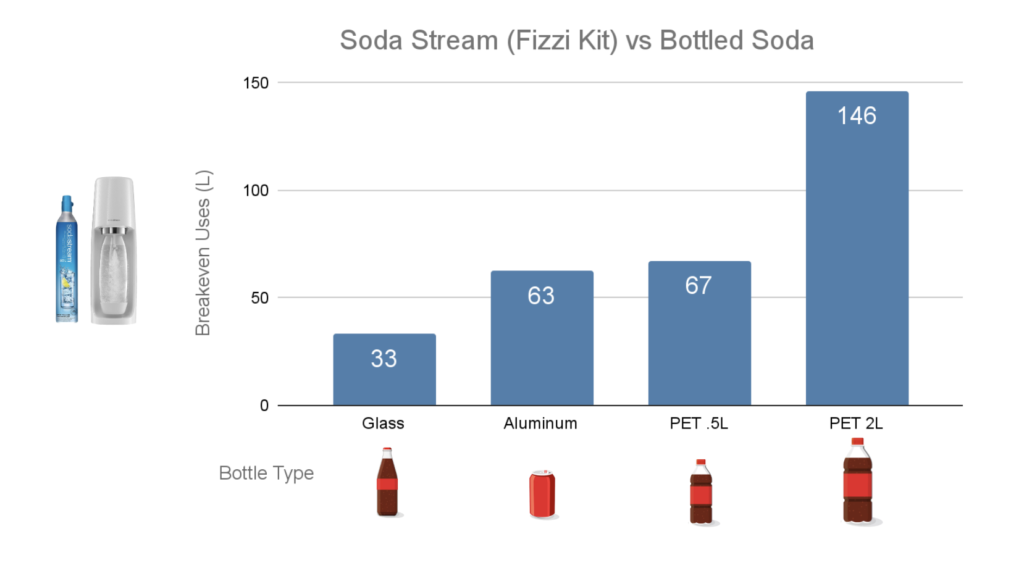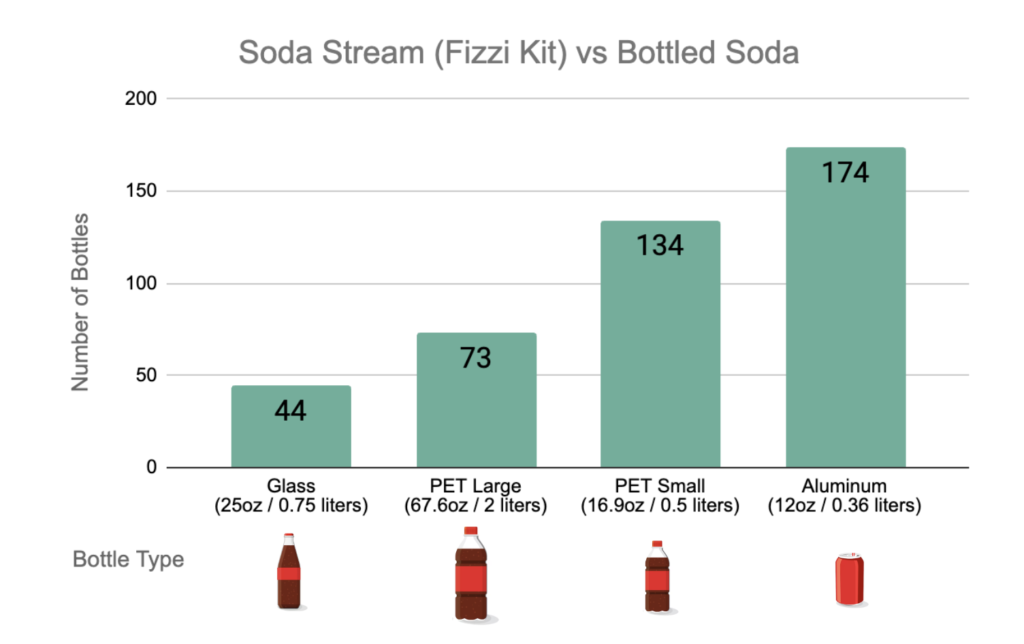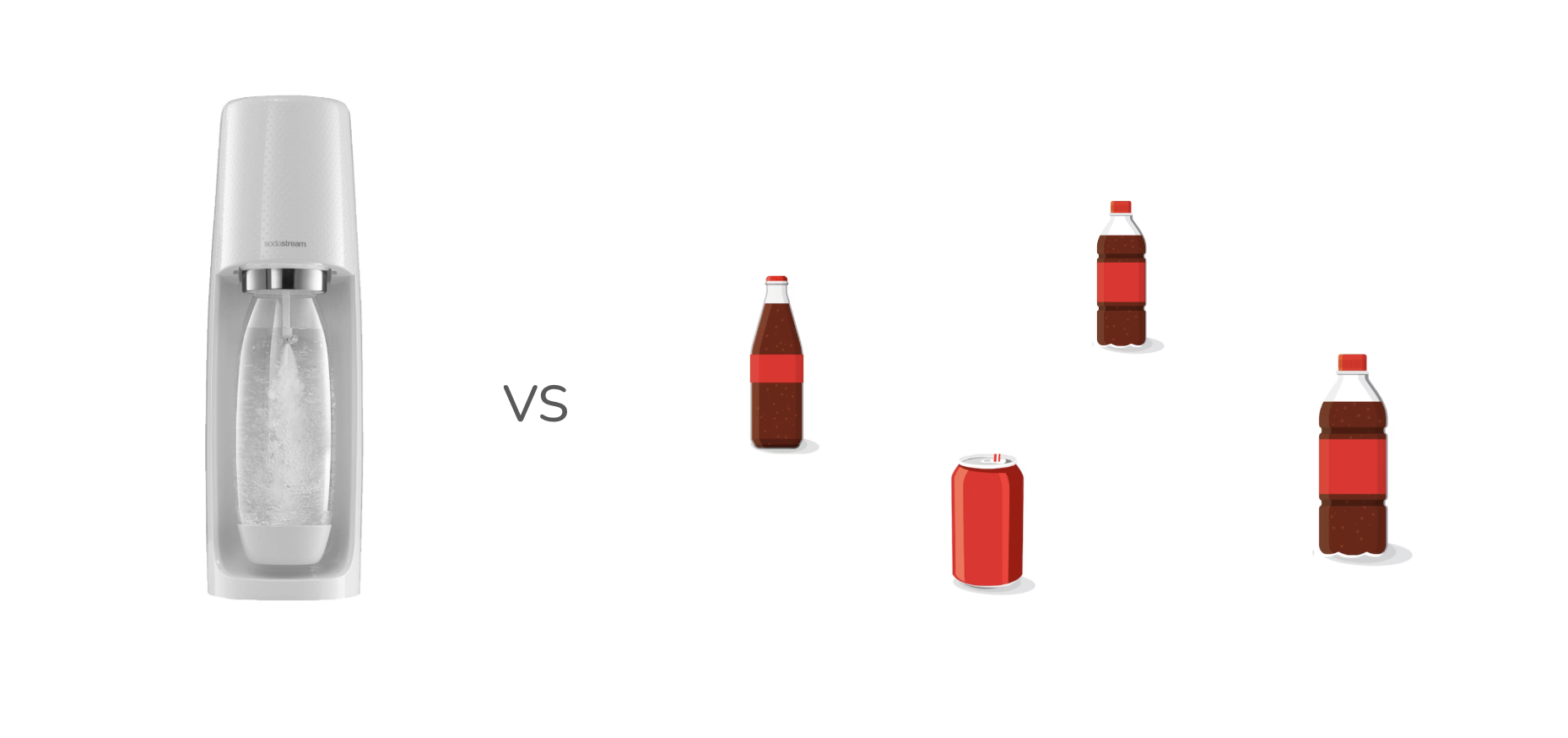Is a home soda machine like Soda Stream more sustainable than buying bottled soft drinks?
Short Answer: A home soda machine can be more sustainable than buying bottled soft drinks, but it may take longer than you expect. You’ll have to make between 44 and 174 servings of your own soda before the soda machine becomes more eco friendly than single-use bottles. Where you fall on this range depends on the type of bottle your displacing (glass, plastic, or aluminum).
Depending on how much soda you drink, the time for it to be more sustainable (and more economic) can be as short as a month or as long as a few years. See the full breakdown by scenario below.
Full Answer: To truly understand the sustainability and economics of a soda machine vs bottled soda we had to dig much deeper…
In this post we break down the environmental impact of a Soda Stream vs soft drinks that come in glass, plastic, and aluminum bottles. We’ll answer these key questions:
- Methodology – How do you evaluate the sustainability of a Soda Stream vs various types of bottled beverages?
- Breakeven Uses – How much soda do you need to make at home before the impact of the Soda Stream machine becomes more sustainable than buying bottles? And how does this differ between materials like plastic vs aluminum and size?
- Economics – How much money can a home soda machine save you?
If you have additional questions after reading this post, please let us know.
Methodology: The GWP of Single-Use vs Soda Stream
To compare the environmental impact of a bottle of soda bought in the store vs a bottle of soda made at home with Soda Stream (or similar machine), we need to find a common metric of comparison. The process to determine the impact of a product from its creation through to its disposal is called a Life Cycle Analysis. The key metric that results from a life cycle analysis is Global Warming Potential (GWP) measured in kilograms of CO2 equivalent (kg CO2 eq).
We’ve found the GWP for the main Soda Stream model and common soft drinks that come in aluminum cans, plastic bottles, and glass bottles. With this information we’re able to calculate and compare the GWP of soda made with the Soda Stream vs a bottled alternative.
Note: Plastic pollution is a separate component, which we have also evaluated and compared so you can see how much plastic is saved by using a home soda machine vs buying plastic bottles.
Here’s what we found:
Environmental Impact: Soda Stream vs Bottled Soda
Each type of bottle used for delivering soda has a different environmental impact. In the context of Global Warming Potential, soda delivered in glass has the highest impact. When it comes to plastic footprint, 0.5L bottles are the worst offender. In most cases, a home soda machine has a lower GWP, but it can take a while to reach this breakeven point.
Here’s how the Soda Stream stacks up against each bottle type:
Breakeven Points by Bottle Type
How much soda do you need to make at home before a Soda Stream has a lower GWP than single-use bottles?
The amount of soda we would need to make at home ranges from 33 liters to 146 liters depending on the type and size of bottles we are comparing it to.
Breakeven Points by Volume
How many liters of soda would you need to displace before a Soda Stream becomes more environmentally friendly?

This chart shows how many liters of soda we would need to make at home in order to make a Soda Stream more sustainable. Since 2L plastic bottles are the most sustainable delivery of soda by volume, it will take more home soda production to become more sustainable. .75L glass bottles, on the other hand, are the least sustainable way to deliver a serving of soda. If you’re buying soda in glass bottles, you can offset your footprint much faster than if you’re buying 2L plastic bottles.
Breakeven Points by Number of Bottles
How many bottles of soda would you need to displace before a Soda Stream becomes more environmentally friendly?

Here is the breakdown by bottle type:
- Aluminum: 174 – you would have to make 174 12oz servings with a soda machine before it becomes more environmentally friendly than buying cans.
- Plastic Bottles (PET)
- 16.9oz (.5L): 134 – it would take about 134 .5L servings to reach breakeven
- 67.6oz (2L): 73 – it would take about 73 2L servings to reach breakeven
- Glass: 44 – you would have to make 44 25oz servings with a soda machine before it become more sustainable than buying glass and more than twice this much if comparing to 12oz glass bottles.
Economics: Soda Stream vs Bottled Soda
How long will it take for my home soda machine to become more sustainable than buying single-use bottles?
AND
When does a Soda Stream become more cost effective than buying bottled soft drinks?
To answer these questions, let’s look at a few scenarios.
Scenario 1: Aluminum Cans vs Soda Stream
The Environmental Question: How long will it take for a soda stream to have a smaller environmental footprint than aluminum cans?
You would need to produce 63 liters of soda, the equivalent of 173 12oz cans, for a Soda Stream to have a lower GWP than buying cans.
Key Takeaways from This Video:
- Environmental Break-Even for Soda Stream vs. Aluminum Cans: To become more environmentally friendly than aluminum cans, a Soda Stream must produce 63 liters of soda.
- Number of Cans To Break-Even: The 63 liters equate to 174 cans of soda. To be more environmentally friendly with a Soda Stream, one would need to replace the consumption of 174 cans.
- Time to Reach Environmental Break-Even:
- Approximately three years for drinking one can per week on average.
- About one year for drinking one can every other day.
- Roughly six months for drinking one can per day.
- About one month for consuming six cans a day.
- Cost Comparison:
- Buying 15 12-packs of cans (180 cans) costs about $112.
- Using a Soda Stream requires a starter pack and flavor refills, totaling approximately $206, but yields more than the equivalent of 174 cans (about 72 liters).
- Overall Expense for Environmental Break-Even: Reaching the environmental breakeven point with a Soda Stream costs around $200.
The Economic Question: How long will it take for a soda machine to be more economical than buying cans?
The Soda Stream becomes cheaper than continuously buying cans after around 400 to 500 servings, which is about $300 worth of soda.
Key Takeaways from This Video:
- Initial Cost of Soda Stream: The first 12-ounce drink from a Soda Stream is initially very expensive due to the initial purchase of the machine. However, this cost significantly decreases as more drinks are made.
- Ongoing Costs for Refills: Users need to buy flavor refills every 36 liters, leading to occasional spikes in the cost per serving. Additionally, CO2 refills are required, albeit less frequently.
- Cost Comparison Over Time: The initial cost for the Soda Stream is higher compared to buying a 12-pack of cans. However, the long-term cost increase of using the Soda Stream is slower than the continual purchase of 12-packs.
- Breakeven Point: Economically, the Soda Stream becomes cheaper than continuously buying cans after around 400 to 500 servings, which is about $300 worth of soda.
- Cost to Reach 500 Servings: To achieve 500 servings, one would either need to buy 42 12-packs of cans (costing about $311) or use a Soda Stream with a starter pack, five flavor refills, and one CO2 refill.
- Time to Economic Break-Even: The duration to reach this economic breakeven point varies based on consumption habits:
- Nearly 10 years for drinking one can per week on average.
- Two and a half to three years for drinking a couple of cans per week.
- One and a half years for drinking one can per day.
Scenario 2: 0.5L Plastic Bottles vs Soda Stream
The Environmental Question: How long will it take for a soda stream to have a smaller environmental footprint than single-use bottles (.5L / 16.9oz)?
Key Takeaways from This Video:
- Breakeven for Environmental Friendliness: A home soda machine becomes more environmentally friendly than single-serve half-liter PET bottles after producing 67 liters of soda, equivalent to displacing 134 of these bottles.
- Time to Reach Environmental Breakeven: The time to reach this breakeven point depends on consumption rate:
- Over two and a half years if you drink one bottle per week.
- Nine months when drinking a bottle every other day.
- About four and a half months when drinking one bottle per day.
- Approximately three weeks if you drink six bottles per day.
- Plastic Footprint Reduction: The home soda machine significantly reduces the plastic footprint compared to single-serve bottles. This is because the soda machine uses fewer refill bottles per serving, as opposed to the rapidly accumulating number of single-serve bottles.
- Cost Comparison for Environmental Break-Even:
- For bottled soda: Buying 22 six-packs (around 138 bottles) to reach 67 liters costs about $115.
- For the soda stream: The starter pack plus one refill pack, totaling close to $200, is needed to reach the same volume.
- Economic Consideration: While it is more expensive initially to use a home soda machine, it becomes more economically viable over time, as well as more environmentally friendly.
The Economic Question: How long will it take for a soda machine to be more economical than buying single-use bottles (.5L / 16.9oz)?
The breakeven point, where the soda machine becomes more economical than buying bottles, is estimated to be around 400 to 500 servings, or approximately $350 in total expenditure.
Key Takeaways from This Video:
- Initial High Cost of Soda Machine: The first half-liter drink made with a soda machine effectively costs around $180 due to the initial purchase of the machine.
- Decreasing Cost Per Serving: The cost per serving decreases significantly as more drinks are made at home, despite the need for occasional flavor refills (every 36 liters) and less frequent CO2 refills (ever 60 liters).
- Break-Even Point: The breakeven point, where the soda machine becomes more economical than buying bottles, is estimated to be around 400 to 500 servings, or approximately $350 in total expenditure.
- Economic Break-Even in Terms of Quantity: To reach an economic breakeven of about 216 liters, one would need to buy 72 six-packs (432 bottles). In contrast, the equivalent amount with a soda stream involves buying a starter pack and sufficient refills, totaling about $313.
- Time to Economic Break-Even: The time to reach the economic breakeven point varies based on consumption: about 8 years for drinking one bottle per week, 4 years for one bottle every other day, and approximately 1 year and 2 months for one bottle per day.
Scenario 3: 2L Plastic Bottles vs Soda Stream
The Environmental Question: How long will it take for a soda stream to have a lower GWP than buying 2-liter soda bottles?
A home soda machine like the Soda Stream becomes more environmentally friendly than two-liter bottles after producing 146 liters of soda, which is 73 2-liter bottles.
Key Takeaways from this Video:
- Global Warming Potential: In terms of global warming potential, the two-liter plastic bottle is initially more environmentally friendly than smaller plastic bottles, aluminum cans, or glass bottles. This is due to more soda being provided per amount of plastic used.
- Break-Even Point for Soda Machine: A home soda machine like the Soda Stream becomes more environmentally friendly than two-liter bottles after producing 146 liters of soda.
- Comparison of Usage: To be more environmentally friendly than a soda machine, one would need to avoid purchasing 73 two-liter bottles, instead producing the equivalent amount of soda at home.
- Time to Environmental Break-Even: Depending on consumption, the time to reach this break-even point varies. It’s approximately 1.5 years for consuming one two-liter bottle per week, 9 months for consuming a couple of bottles per week, and less than 3 months for daily consumption.
- Plastic Footprint: Over time, the number of two-liter bottles used grows faster than the refill bottles needed for a home soda machine. This difference highlights the potential for reducing your plastic footprint.
- Cost Comparison: To reach the environmental break-even point of 146 liters, the cost is around $143 for purchasing 73 two-liter bottles. In comparison, to achieve the same amount with a Soda Stream, the initial investment is higher due to the cost of the starter kit, flavor refills, and CO2. To exceed 146 liters with a Soda Stream it will cost over $300.
- Overall Economic and Environmental Considerations: While it’s more expensive to use a soda machine initially, it becomes more environmentally friendly over time. The economic aspect of using two-liter bottles versus a soda stream is also a factor to consider, with the two-liter bottle being more economical initially.
The Economic Question: How long will it take for a soda machine to be more economical than buying 2-liter soda bottles?
The soda machine becomes more economical after approximately 600 to 700 servings, equating to around $1,300 worth of soda.
Key Takeaways in This Video:
- Initial High Cost of Soda Machine: The cost of creating the first two liters of soda with a machine is high due to the need to buy the machine, flavoring, and CO2.
- Recurring Costs for Flavor and CO2: Frequent purchases of flavor refills and CO2 are required, especially because of the high volume of soda produced compared to smaller packages like 12-ounce cans or half-liter bottles.
- Comparison of Total Costs Over Time: Initially, the cost trajectory of using a soda machine is high due to frequent refills. However, over time, it becomes more cost-effective compared to the constant cost of two-liter bottles.
- Break-Even Point: The soda machine becomes more economical after approximately 600 to 700 servings, equating to around $1,300 worth of soda.
- Long-Term Savings: Beyond the break-even point, the cost per liter for the soda machine continues to decrease compared to the cost of buying two-liter bottles.
- Quantity Comparison: To reach 1,332 liters, one would need to buy 666 two-liter bottles or use a soda machine with a starter pack, 38 four-packs of flavoring, and 18 CO2 refills.
- Time to Reach Economic Breakeven Point: Depending on consumption habits, reaching the breakeven point can vary from 13 years (for one two-liter bottle per week) to about two years (for daily consumption of one bottle).
FAQ
How is the life cycle of each bottle type calculated?
Each step throughout the life of a bottle is evaluated and its GWP is quantified. The sum of each step provides the overall Global Warming Potential for each bottle type. We accessed this information from a life cycle analysis research paper on glass, aluminum, and plastic bottles [1].
Key Takeaways from LCA of Bottled Soda Beverages:
- The Production phase of each bottled beverage type (glass, aluminum, plastic) accounts for the biggest impact within its life cycle.
- Glass has the biggest impact on a per-liter basis, followed by aluminum and then plastic
Resources
[1] Life cycle environmental impacts of carbonated soft drinks; Amienyo et al. (2013), Accessed on Dec 23, 2023 on ResearchGate
[2] SodaStream 2020 Sustainability Report, Accessed on Dec 23, 2023

